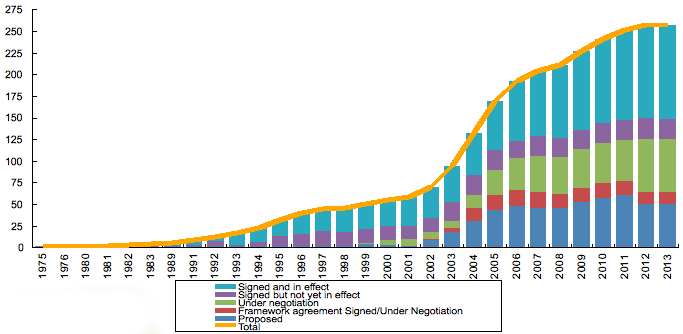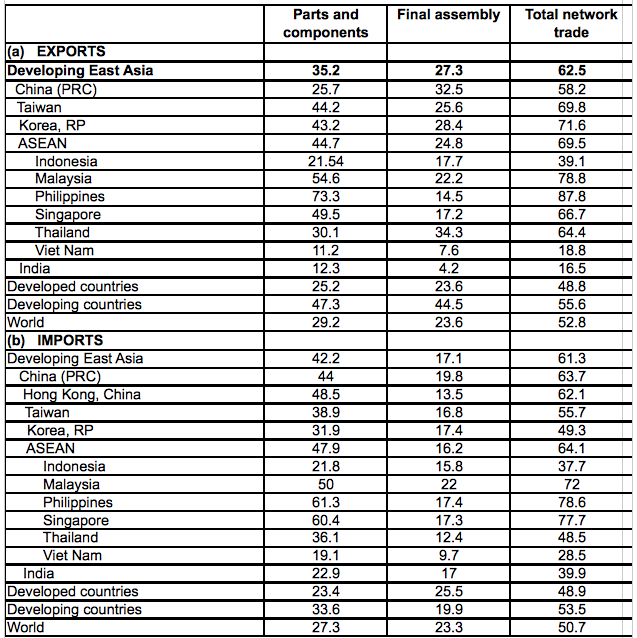Free trade agreements (FTAs) have been proliferating in Asia for more than a decade. Production networks and the product-fragmentation trade that they generate have been growing for a much longer period. In fact, since ‘Factory Asia’ emerged, well before FTAs (Baldwin 2008). They are clearly not necessary for the formation of production networks, but can they support production networks’ further growth and/or spread?
Empirical studies cannot provide a clear answer because they produce mixed results, possibly reflecting dual causality – growth in fragmentation trade may be inducing FTAs, or vice-versa (see Menon 2013). Therefore, this paper employs a qualitative approach that carefully examines the characteristics of product fragmentation trade and FTAs in Asia to ascertain possible linkages, taking into account the presence of other trade policies that can affect the relationship. We find the link between the two to be tenuous.
Growth in FTAs and production networks in Asia
Figure 1 tracks the growth of FTAs that involve at least one country from Asia, together with their status of implementation. Between 1983 and 1999, the number of FTAs in the region grew at a slow but steady pace. From 2000, however, this growth started to accelerate. Between 2000 and 2004, the number of FTAs proposed, under negotiation, or signed more than doubled from 55 to 132; since 2004, this number nearly doubled again to reach 257 by January 2013. Of these 257 FTAs, 132 have been signed and 109 of these are already in effect.
Figure 1. FTAs by status: Total Asia (cumulative), selected years
Notes: Proposed = the parties consider an FTA; governments or relevant ministries issue a joint statement on its desirability or establish a joint study/joint task force to conduct feasibility studies. Framework agreement signed/under negotiation = the parties, through relevant ministries, negotiate the contents of a framework agreement (FA) that serves as a framework for future negotiations. Under negotiation = the parties, through relevant ministries, declare the official launch of negotiations, or start the first round of negotiations. Signed but not yet in effect = the parties sign the agreement after negotiations have been completed, but the agreement has yet to become effective. Signed and in effect = FTA provisions become effective, after legislative or executive ratification.
Source: ARIC FTA database (as of 2013), Asian Development Bank.
Fragmentation trade is much higher in east and southeast Asia than in any other region in the world (Table 1). In 2009/10, fragmentation exports accounted for 62.5% of total manufacturing exports in the region, compared with the world average of 52.8%. Parts and components accounted for more than half of total fragmentation exports in the region during the same period. This share is much larger than the share of parts and components among world exports and intra-regional exports in the EU and NAFTA. While a high and rising share of intra-regional exports consists of fragmentation trade, the bulk of final goods are exported to countries outside the region (Athukorala 2011). Despite recent increases in South–South trade, much of developing Asia’s trade prospects is still dependent on markets outside the region, confirming the view that production networks are generally more global than regional.
Table 1. Share of network products in manufacturing trade, 2009/10 (%)
Source: Athukorala (2011).
Can preferential tariff reductions affect fragmentation trade?
How can FTAs, or their expansion, affect fragmentation trade? It is argued that trade within global production networks is more sensitive to tariff changes than trade in final goods because of multiple border crossings. Consequently, a one percentage point reduction in tariff rates within the consolidated bloc, for instance, leads to a decline in the cost of production of a vertically integrated good by a multiple equal to the number of borders crossed within the bloc. In theory, the trade-stimulating effects of FTAs would be higher for fragmentation trade than for trade in final goods, other things remaining unchanged. Enthused by this theoretical prospect, some have concluded, somewhat prematurely it would seem, that FTAs can support production networks (eg. Kawai and Wignaraja 2013).
How does this pan out in practice? There are a number of reasons why the impacts of FTAs in Asia may be limited:
Most if not all fragmentation trade already travels duty-free or at very low tariffs across the region. Most important is the Information Technology Agreement, a multilateral agreement of the WTO, currently being enhanced (Information Technology Agreement II), since most fragmentation trade in Asia involves products classified as electronics parts and components.
Even for non-electronics trade, it appears that FTAs have little to offer since most of the firms involved in production networks (mostly multinational enterprises) are located in export processing or free trade zones. Those operating outside free trade zones normally enjoy import duty exemptions under duty–drawback and bonded warehouse schemes (Menon 2013).
These factors operate against a backdrop of low and falling tariffs on parts and components, which have more to do with unilateral actions than preferential ones. In this respect, Vézina (2010) suggests that a highly liberalising race-to-the-bottom unilateralism occurred in emerging Asia in the 1980s and 1990s in order to attract foreign direct investment from Japan (see also Baldwin 2010, 2011). As a result, the trade-weighted preference margin for intra-ASEAN trade in 2008 was a mere 2.3%, while 72.9% of trade traveled at a zero most favoured nation rate (WTO 2011).
Even if we put aside the Information Technology Agreement, free trade zones, and duty-drawback schemes, it appears that FTAs are still unlikely to play much of a role in promoting this type of trade due to their need to exclude non-members. The impact that preferential tariff reductions can have on fragmentation trade relates to the need to implement rules of origin in order to exclude trade that does not comply with or meet minimum requirements. First, unlike trade in final goods, formulating and implementing rules of origin for production network trade is far more complicated. If the conventional value-added criterion is employed, it is highly unlikely that intermediate inputs emanating from outside the region will qualify. This is because the activities involved are low value-adding by their very nature. If, on the other hand, the change in tariff-line-based rules of origin is applied, then this may disqualify inputs from both outside and inside the region once they travel across the next border. This is because trade in parts and components generally belong to the same tariff codes at the HS-6 digit level, which is the normal base for designing this type of rules of origin (Athukorala and Kohpaiboon 2011),
Are deeper FTAs the answer?
If FTAs are largely redundant when it comes to reducing tariffs on fragmentation trade, then they have proven largely incapable of addressing trade facilitation aspects that matter when it comes to promoting this type of trade in Asia. A number of studies also confirm the failure of many of the FTAs involving an Asian partner to deepen their coverage, and to deal adequately with trade facilitation issues. WTO (2011) finds that most of the FTAs show relatively limited WTO-plus or GATS-plus commitments in their design.
Does the answer then lie with deepening FTAs? There is a fundamental problem with FTAs that limit their usefulness- the need to be preferential or discriminatory in the provision of the concession or reform. But unlike tariff liberalisation, it is often difficult or costly to remove non-tariff barriers or measures in a preferential manner. It is usually impractical for these types of concessions to be exchanged in a discriminatory fashion – once non-tariff barriers or measures are removed, the cost of excluding non-members is likely to be high, if not prohibitive, like with most public goods.
Even if it were possible to exclude third parties, other complications could arise. UNESCAP (2011) finds that preferential treatment negotiated with selected trading partners typically involves additional documentary requirements leading to further delays. Since FTAs tend to vary in terms of their scope, depth, and level of detail, such as adopting different approaches to the rules on substantive measures in relation to trade facilitation, this can translate into varying degrees of administrative inefficiency, through a maze of different procedures applied to respective trading partners under different FTAs.
What are the alternative modalities of reform?
If the costs associated with complying with FTA-based trade facilitation provisions are high, then the benefits that flow are also generally quite low, when compared with other modalities of liberalisation. Although FTAs may provide a framework for foreign multinationals looking to invest, many of the safeguards are usually already in place these days, arising from the competition to attract foreign direct investment that predates most FTAs. For instance, important safeguards such as protection against nationalisation of investment, or repatriation of profits, are usually provided for in the respective Constitutions of host countries (see Athukorala and Menon 1997). Again, there is little that late-comer FTAs can add to these domestic initiatives and, if and where there are gaps, these are better addressed by investment agreements or treaties.
But there are many additional reforms that can add value, but these cannot be provided by preferential instruments such as FTAs, that also distinguish between foreign and domestic in their design. The results reported in Dee (2006) show that if deep economic integration initiatives were limited to reform of regulations that explicitly discriminated against foreigners, and that the reforms were undertaken on a preferential basis, they would add only trivially to the gains from preferential liberalisation of tariffs on merchandise trade. Therefore, regulatory reforms in the services and investment areas that involve unilateral actions that deal with incumbency (irrespective of whether domestic or foreign) are the best way forward in promoting production networks.
In addition, the WTO can still play a role in coordinating the reform effort in a non-preferential manner. The difficulty of reaching agreement on Doha’s ambitious all-or-nothing single-undertaking program is becoming increasingly clear. Attention has therefore shifted towards a compromise involving sectoral deals, including one that addresses trade facilitation. The benefits to be derived from successfully concluding a sectoral deal on trade facilitation should not be underestimated. The WTO-based trade facilitation negotiations aim to bring these logistical costs down by half, or to an average of 5% of trade costs, which is the equivalent of removing all current tariffs. These are potential gains that are substantial enough to warrant serious consideration and perhaps counter concerns over the reduced incentives to conclude a more comprehensive deal that has been elusive for a very long time.
Conclusion
Rather than supporting ‘Factory Asia’, it is more likely that fragmentation trade has prospered despite the noodle bowl of overlapping FTAs in the region. Intra-regional FTAs appear to have had little effect on either the growth or spread of production networks. Most fragmentation trade already travels at zero or low tariffs because of the Information Technology Agreement, various duty-drawback or bonded warehouse schemes, and the location of most multinationals in duty-exempt free trade zones or export processing zones. Even trade not covered by these schemes is unlikely to benefit from FTA tariff concessions because of its inability to satisfy rules of origin, as a result of limited value-addition and/or classification problems relating to ‘tariff-line shifting’.
Inter-regional FTAs, on the other hand, may have been able to indirectly support the growth of production networks among existing members, if they lead to increased demand for the final goods that the networks produce, but not the spread to new ones. FTAs are designed to promote trade in final goods, or goods which are produced from beginning to end in a given country, and not the type of fragmentation trade involving parts and components and final assembly within production networks. Also, almost all FTAs involving Asian countries are relatively shallow, focusing on tariff reductions rather than addressing trade facilitation and other non-tariff barriers that could have a greater impact on promoting production networks. Even if they were to deepen over time, it is difficult or costly to remove non-tariff barriers in a preferential manner. Therefore, a non-discriminatory modality such as a WTO-based multilateral agreement on trade facilitation would work better in reducing the kinds of logistical costs that affect fragmentation trade. This, combined with national actions that deal with regulatory reforms, and address incumbency issues (irrespective of nationality) would be the best way to support the growth of production networks in current participants and their spread to new ones.
Disclaimer: The views expressed here are those of the author and do not necessarily represent those of the institutions with which he is affiliated.
References
Athukorala, PC (2011), “Production Networks and Trade Patterns in East Asia. Regionalization or Globalization?”, Asian Economic Papers 10(1), 65–95.
Athukorala, PC and A Kohpaiboon (2011), “Australian–Thai Trade: Has the Free Trade Agreement Made a Difference?”, Australian Economic Review 44(4), 457–67.
Athukorala, PC and J Menon (1997), “AFTA and the Investment-trade Nexus in ASEAN”, The World Economy 20(2), 159-74.
Baldwin, 9 (2010). “Unilateral Tariff Liberalisation” in The International Economy: Journal of The Japan Society of International Economics, 14, 10–43.
Baldwin, R (2011), “21st Century Regionalism: Filling the Gap between 21st Century Trade and 20th Century Trade Rules”, CEPR Policy Insight 56, May.
Baldwin, Richard (2008), “Managing the Noodle Bowl: The fragility of East Asian Regionalism”, Singapore Economic Review, 53(03), April, 449-478; CEPR Discussion Paper 5561, 2006.
Dee, P (2006), “East Asian Economic Integration and its Impact on Future Growth”, World Economy 30(3), 405–23.
Kawai, M and G Wignaraja (2013). “Patterns of Free Trade Areas in Asia”, Policy Studies No. 65, Honolulu, East West Center.
Menon, J (2013), “Supporting the Growth and Spread of International Production Networks in Asia: How Can Trade Policy Help?”, ADB Working Paper Series on Regional Economic Integration No. 114, Manila, ADB.
UNESCAP (2011), Trade Facilitation in Regional Trade Agreements, Bangkok, UNESCAP.
Vézina, PL (2010), “Race-To-The-Bottom Tariff Cutting”, IHEID Working Paper, 12-2010. Geneva, IHEID.
WTO (2011), World Trade Report 2011, Geneva, WTO.




